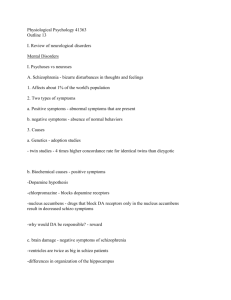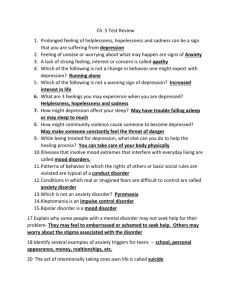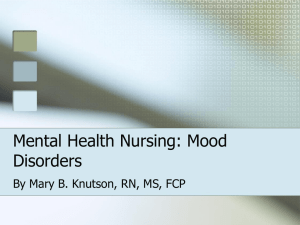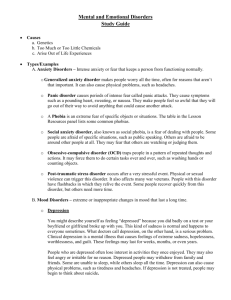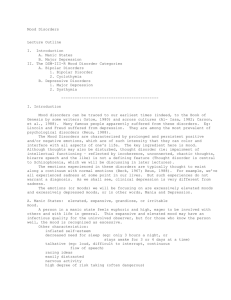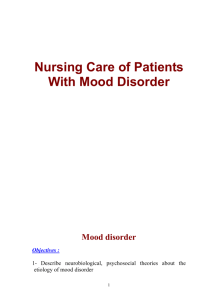Mood (Affective) Disorders
advertisement
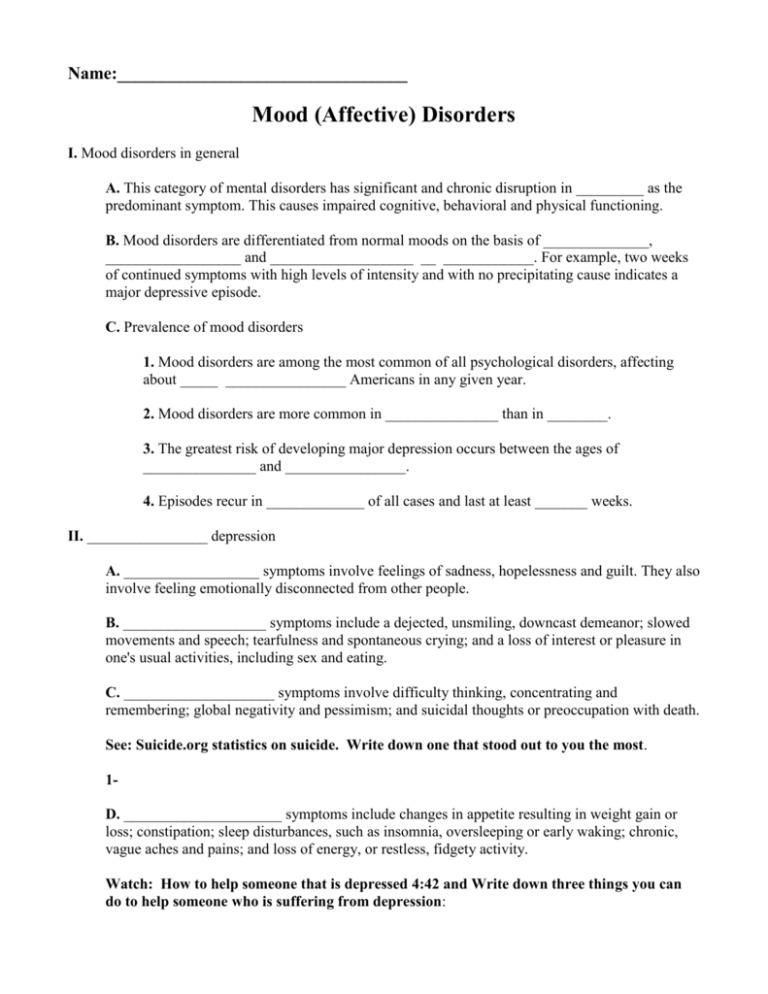
Name:_________________________________ Mood (Affective) Disorders I. Mood disorders in general A. This category of mental disorders has significant and chronic disruption in _________ as the predominant symptom. This causes impaired cognitive, behavioral and physical functioning. B. Mood disorders are differentiated from normal moods on the basis of ______________, __________________ and ___________________ __ ____________. For example, two weeks of continued symptoms with high levels of intensity and with no precipitating cause indicates a major depressive episode. C. Prevalence of mood disorders 1. Mood disorders are among the most common of all psychological disorders, affecting about _____ ________________ Americans in any given year. 2. Mood disorders are more common in _______________ than in ________. 3. The greatest risk of developing major depression occurs between the ages of _______________ and ________________. 4. Episodes recur in _____________ of all cases and last at least _______ weeks. II. ________________ depression A. __________________ symptoms involve feelings of sadness, hopelessness and guilt. They also involve feeling emotionally disconnected from other people. B. ___________________ symptoms include a dejected, unsmiling, downcast demeanor; slowed movements and speech; tearfulness and spontaneous crying; and a loss of interest or pleasure in one's usual activities, including sex and eating. C. ____________________ symptoms involve difficulty thinking, concentrating and remembering; global negativity and pessimism; and suicidal thoughts or preoccupation with death. See: Suicide.org statistics on suicide. Write down one that stood out to you the most. 1D. _____________________ symptoms include changes in appetite resulting in weight gain or loss; constipation; sleep disturbances, such as insomnia, oversleeping or early waking; chronic, vague aches and pains; and loss of energy, or restless, fidgety activity. Watch: How to help someone that is depressed 4:42 and Write down three things you can do to help someone who is suffering from depression: 123III. Other depressed mood disorders A. ______________________ disorder involves chronic, low-grade feelings of depression that produce subjective discomfort but, unlike major depression, does not seriously impair one's ability to function. Watch What is Chronic Depression (Mental Health Guru) 4:44 Write down two things you learned: 12B. _________________ __________________ ___________________ (SAD) involves episodes of depression which typically recur in fall and winter and remit during spring and summer. Watch Young and ___________ in Seattle 1:01 (search Seasonal Affective Disorder Seattle) C. _________ ______________ __________________ depression following birth: a psychiatric disorder consisting of severe depression that can affect a woman soon after giving birth to a baby Watch Brooke Shields Interview with Oprah 3:22 (search Brook Shields post partum) 1- What surprised you the most about what she said? Watch 12/09/01 Why Did She Do It? 6:05 Do you think she should have been found not guilty due to insanity? Defend your answer: D. _______________ _________________________ ___________ ___________ (PTSD) is a mental health condition that's triggered by a terrifying event. Symptoms may include flashbacks, nightmares and severe anxiety, as well as uncontrollable thoughts about the event. Watch “Post Traumatic Stress Disorder” from the Amen Clinic 6:14 and name 2 things you learned. 12- IV. __________________ disorder is characterized by alternating episodes of major depression and mania. A. Characteristics of mania include 1. Emotional symptoms, such as __________________, expansiveness and excitement (feeling "on top of the world"). 2. Behavioral symptoms, such as out-of-character _____________ or activity, frenzied, disorganized goal-directed activity, rapid-fire speech, spending sprees and illegal acts, and severely disrupted sleep patterns often resulting in little or no sleep over a number of days. 3. Cognitive symptoms, such as wildly inflated self-esteem, _________________ (sometimes involving delusional beliefs), easy distractibility leading to a flight of ideas in which thoughts rapidly and loosely shift, irritability and verbal abusiveness if grandiose ideas are questioned. B. Prevalence and course 1. Annually about _____ ______________ Americans suffer from bipolar disorder. 2. Onset typically occurs in the early ____________________. 3. The disorder affects men and women at the ____________ rate. 4. It is a recurring, chronic disorder that generally responds favorably to _________ _____________________. C. ___________________ disorder, a milder, but chronic form of bipolar disorder, involves moderate but frequent mood swings. People with the disorder are perceived as extremely moody, unpredictable, and inconsistent. Watch Bipolar Overview 6:30 and write down three observations: 123V. Explaining affective disorders A. The biopsychological perspective 1. Family, twin and adoption studies indicate that some people inherit a __________________predisposition for mood disorders. 2. Indirect evidence indicates that two neurotransmitters, _________________ and norepinephrine, are implicated in major depression. 3. Symptoms of major depression are alleviated in about _______ percent of people for whom antidepressant medication is prescribed. These medications increase the availability of seratonin and norepinephrine in the brain. 4. Continued use of antidepressants can _______________ recurrences of major depression. B. The behavioral perspective stresses the role of reinforcement. 1. Depressed people may lack the _____________ _______________ needed to gain normal social reinforcement from others. 2. Thus, a vicious cycle develops in which reduced social reinforcement leads to depression, and depressed behavior further reduces social reinforcement. C. The cognitive perspective stresses that the way people _____________ can result in depression. 1. ______________________ set themselves up for depression through irrational selfdemands they may not be able to meet. 2. Paying attention to negative information, being highly _________ - ______________, being pessimistic about the future and focusing on the cause of the negative mood all contribute to depression. 3. Making attributions that are internal ("it's all my fault"), stable ("nothing can change to improve the situation") and global ("it is a major, all-encompassing problem") may cause depression. D. The biopsychosocial perspective recognizes the roles played by an individual's biochemistry, behavior and mood (along with environmental stress factors), thus acknowledging that depression is an ailing mind in an ailing body. It also acknowledges that altering any one of the components of the chemistry-cognition-mood circuit can affect the others.

